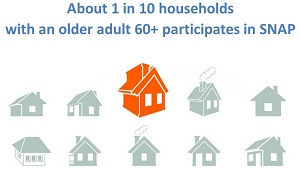Media Contact:
Emily Pickren
epickren@frac.org
202-640-1118
 WASHINGTON, October 31, 2018 — One in 10 households with seniors (age 60+) participated in the Supplemental Nutrition Assistance Program (SNAP), on average each year between 2012–2016. This is according to U.S. Census Bureau data analyzed in interactive tools released today by the Food Research & Action Center (FRAC), in collaboration with AARP Foundation.
WASHINGTON, October 31, 2018 — One in 10 households with seniors (age 60+) participated in the Supplemental Nutrition Assistance Program (SNAP), on average each year between 2012–2016. This is according to U.S. Census Bureau data analyzed in interactive tools released today by the Food Research & Action Center (FRAC), in collaboration with AARP Foundation.
These first-of-their-kind interactive maps and accompanying tables show the share of all households with seniors that participated in SNAP nationally, in each state, and among the nation’s 3,142 counties. Seventeen percent of all counties have rates of senior household SNAP participation that are higher than the national average of 10.2 percent, ranging from 12.1 percent in Franklin County, Ohio to 47.7 percent in Starr County, Texas. Overall, 39 states included at least one county with a participation rate above the national average, 21 states had at least ten counties with rates above the national average, and seven states had more than 20 counties with SNAP participation rates in senior households that were higher than 10.2 percent. In 11 states, at least a third of the counties had rates above the national average, and in New Mexico, Washington, South Carolina, New York, Alabama and Florida, at least 25 percent of counties had rates higher than the national average.
Participation among senior households, on average, is consistent for all types of counties across the country, i.e., rural, small town, and metropolitan areas.
“SNAP provides seniors with essential resources to keep food on the table and get the nutrition they need for their health and well-being,” said Jim Weill, president, Food Research & Action Center. “SNAP serves as the first line of defense against hunger and is critical to keeping and lifting low-income households with seniors out of poverty and hunger.”
These interactive tools allow local, state, and national policymakers, program administrators, advocates, media, social service providers and others to better understand the role of SNAP in helping millions of struggling seniors afford enough food to eat in their communities and nationwide.
While these maps show the percentage of all households with seniors that participate in SNAP, they do not provide information on the percentage of eligible households with seniors that participate in the program. Despite the program’s many benefits, just two out of five eligible households with seniors nationally participate in SNAP, according to the U.S. Department of Agriculture. Older adults often face a number of barriers to enrolling in SNAP, including not knowing they are eligible or feeling stigma about receiving food assistance. However, research shows that older adults who do participate in SNAP benefit from a range of positive outcomes, including improved health, better nutrition, and lower health care costs.
“We need to do everything we can to ensure SNAP is being used to its full extent, especially by older adults. People should not have to skip meals, choose between food and medicine, or postpone medical care because they are eligible for but not receiving SNAP,” said Weill.
In February 2018, FRAC and AARP Foundation released an online course for health care providers, Screen & Intervene: Addressing Food Insecurity Among Older Adults, to learn how to screen patients age 50 and older for food insecurity and connect them to key nutrition resources such as SNAP.
###
These interactive maps complement FRAC’s SNAP maps, which show overall SNAP household participation in every U.S. county and state. They are based on American Community Survey (ACS) five-year data (2012–2016). Each county is grouped into one of three census categories: Metro, Small Town, or Rural. Accompanying the senior SNAP maps are interactive, searchable tables that allow users to look at and compare senior household SNAP participation by state and county.
About the Food Research & Action Center
The Food Research & Action Center is the leading national nonprofit organization working to eradicate poverty-related hunger and undernutrition in the United States. Visit frac.org to learn more.
About AARP Foundation
AARP Foundation works to end senior poverty by helping vulnerable older adults build economic opportunity and social connections. As AARP’s charitable affiliate, AARP Foundation serves AARP members and nonmembers alike. Bolstered by vigorous legal advocacy, the Foundation sparks bold, innovative solutions that foster resilience, strengthen communities and restore hope. To learn more about AARP Foundation visit aarpfoundation.org.

